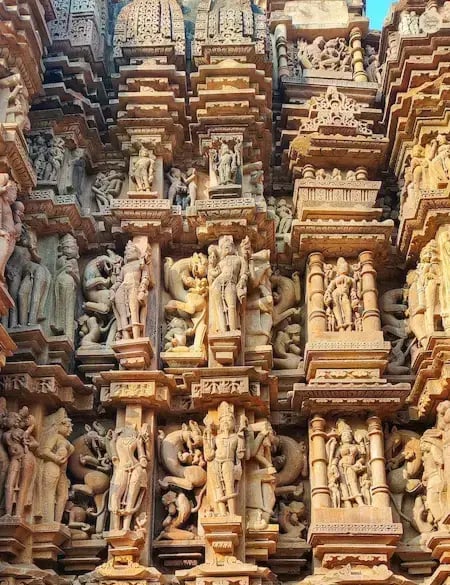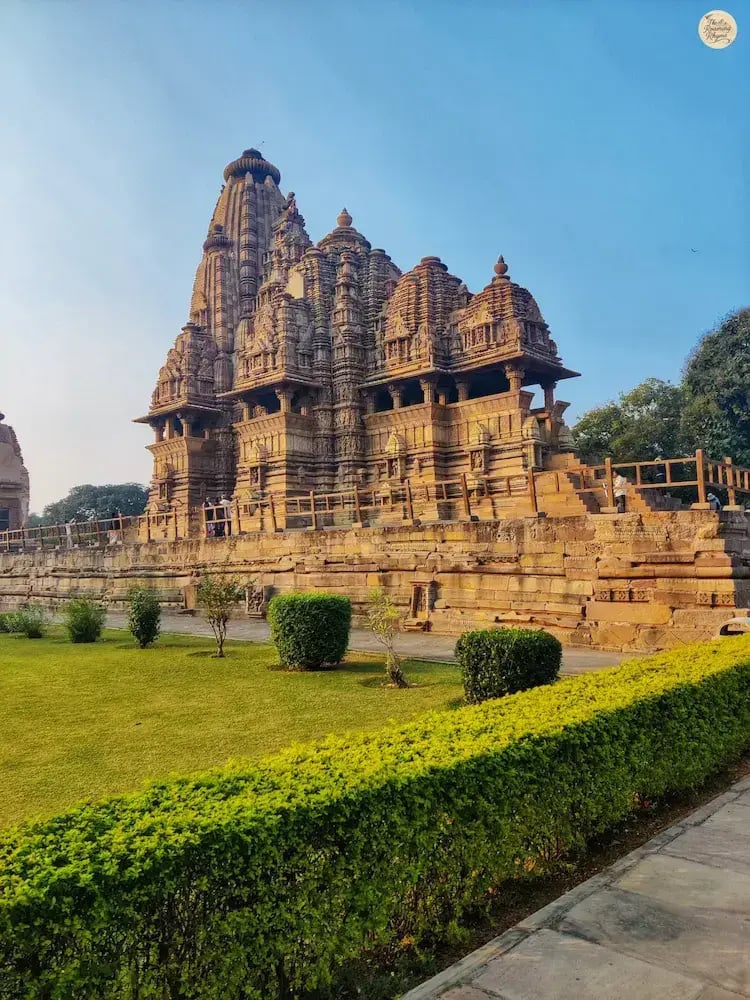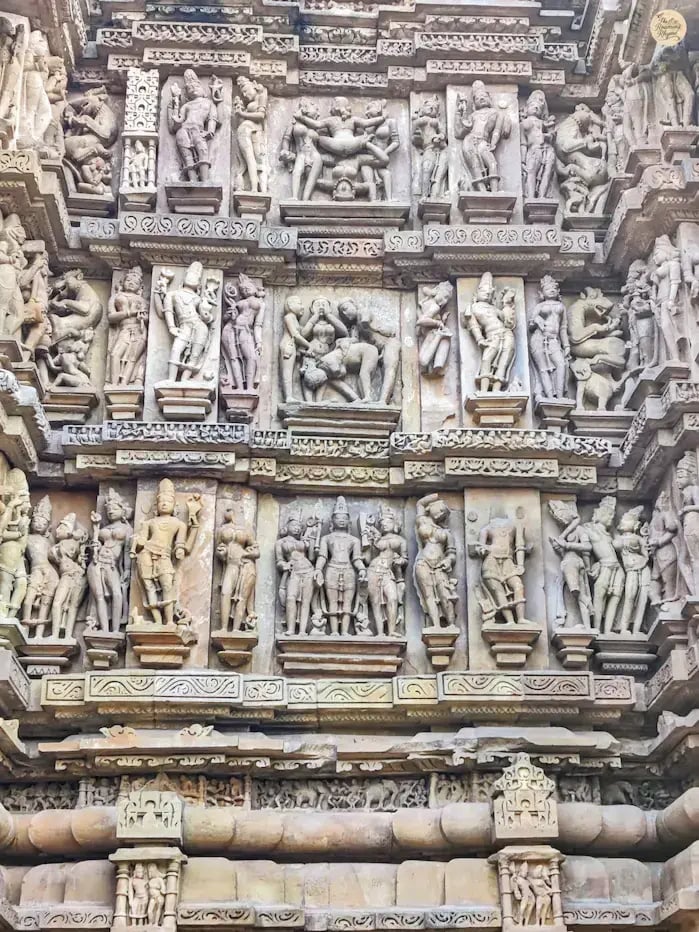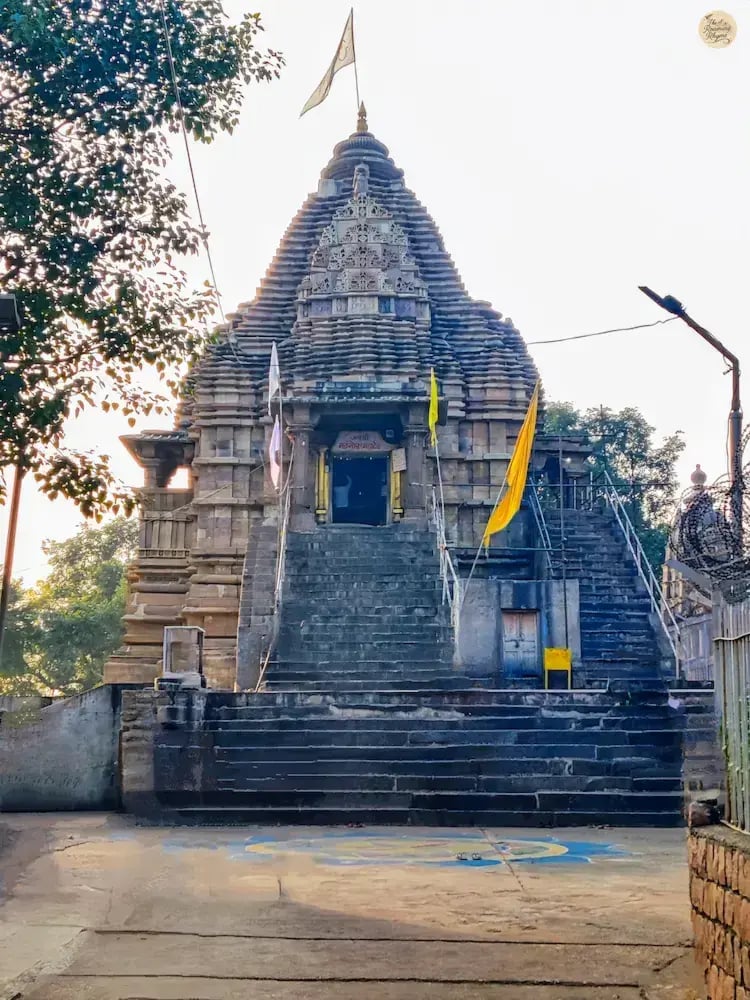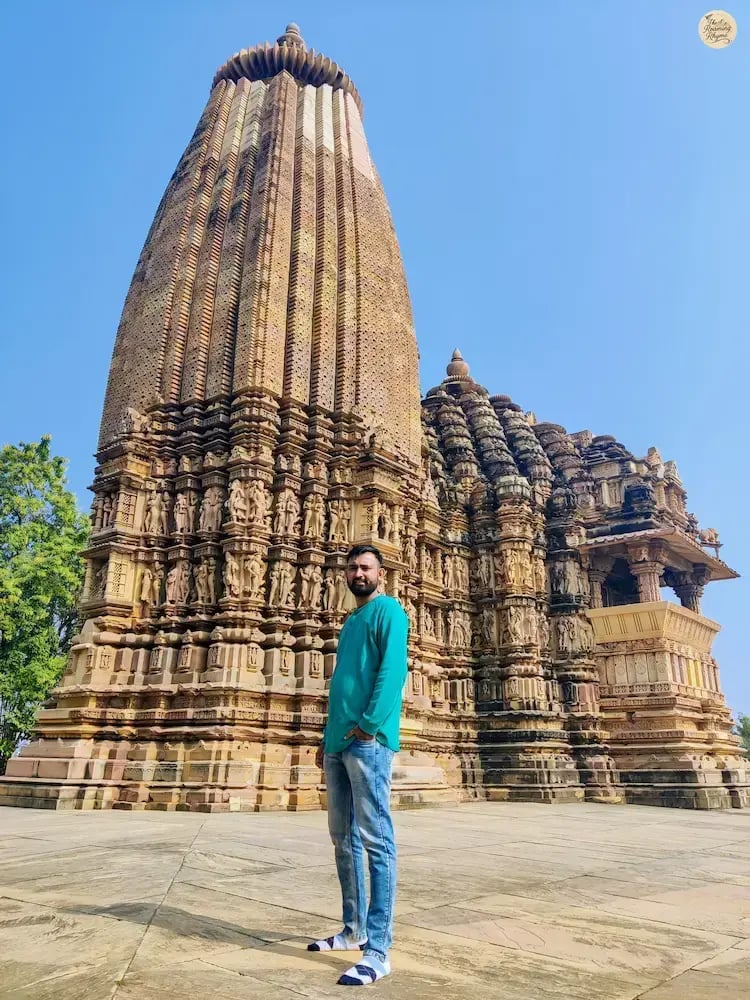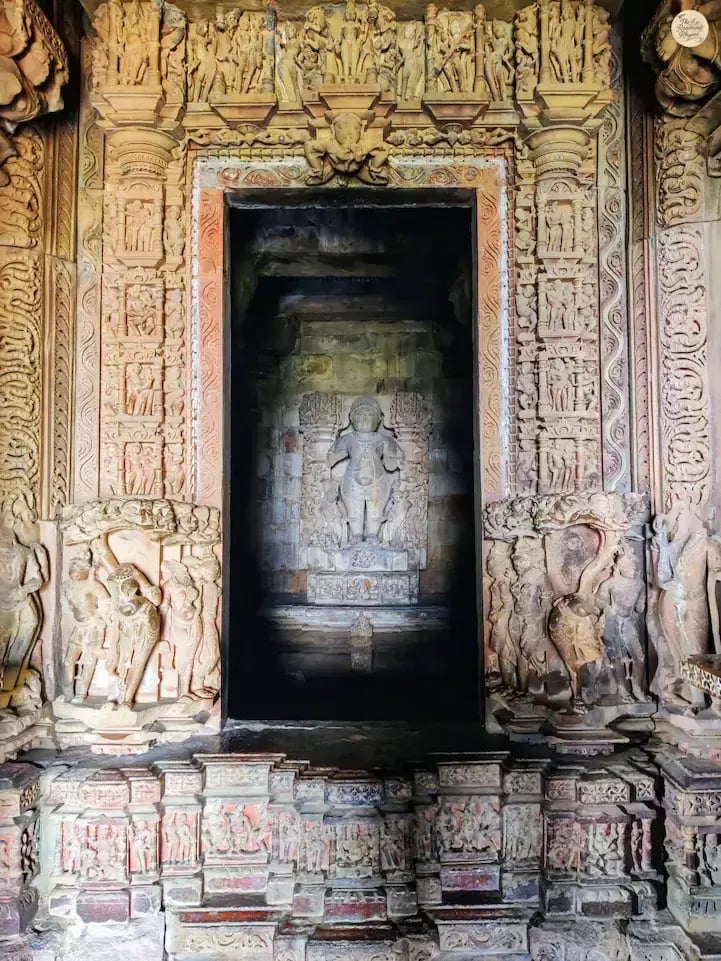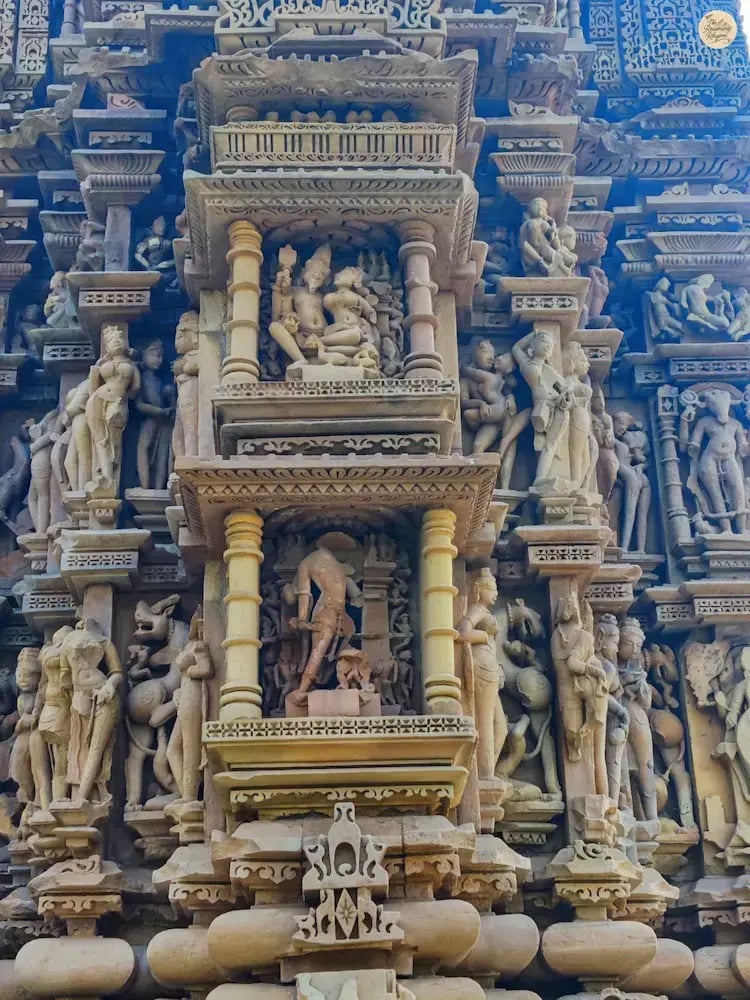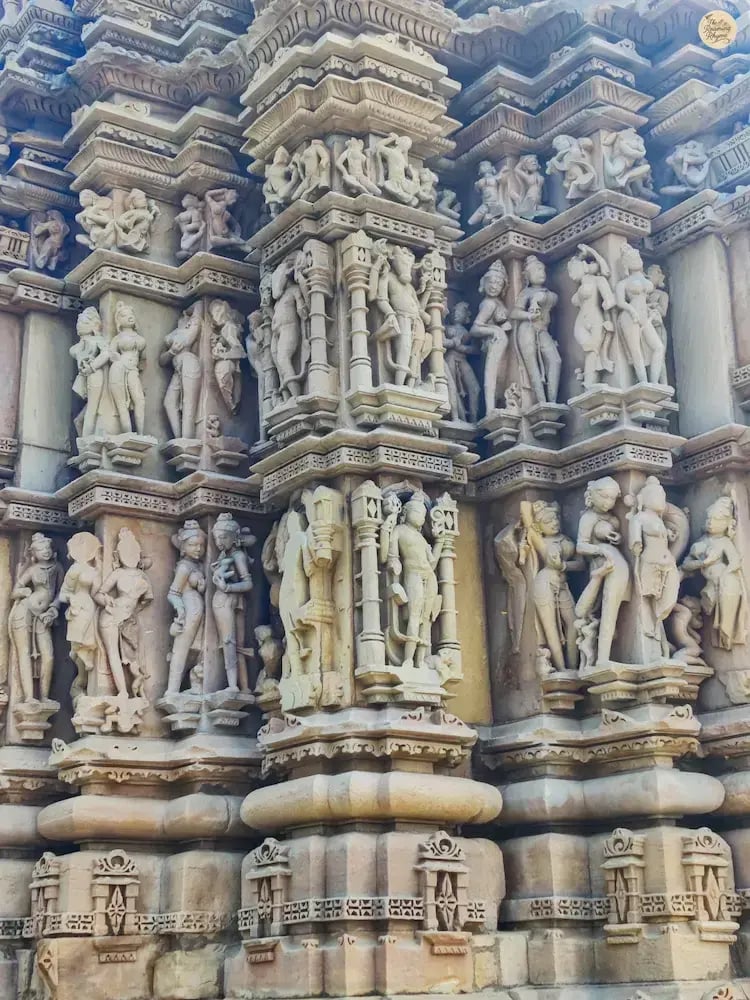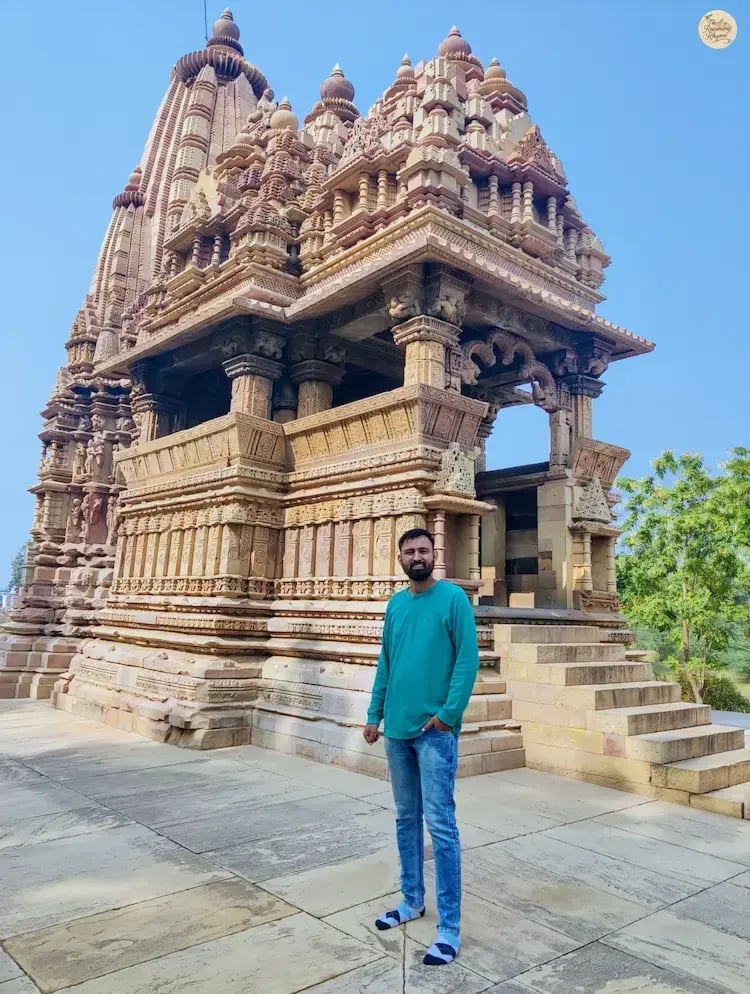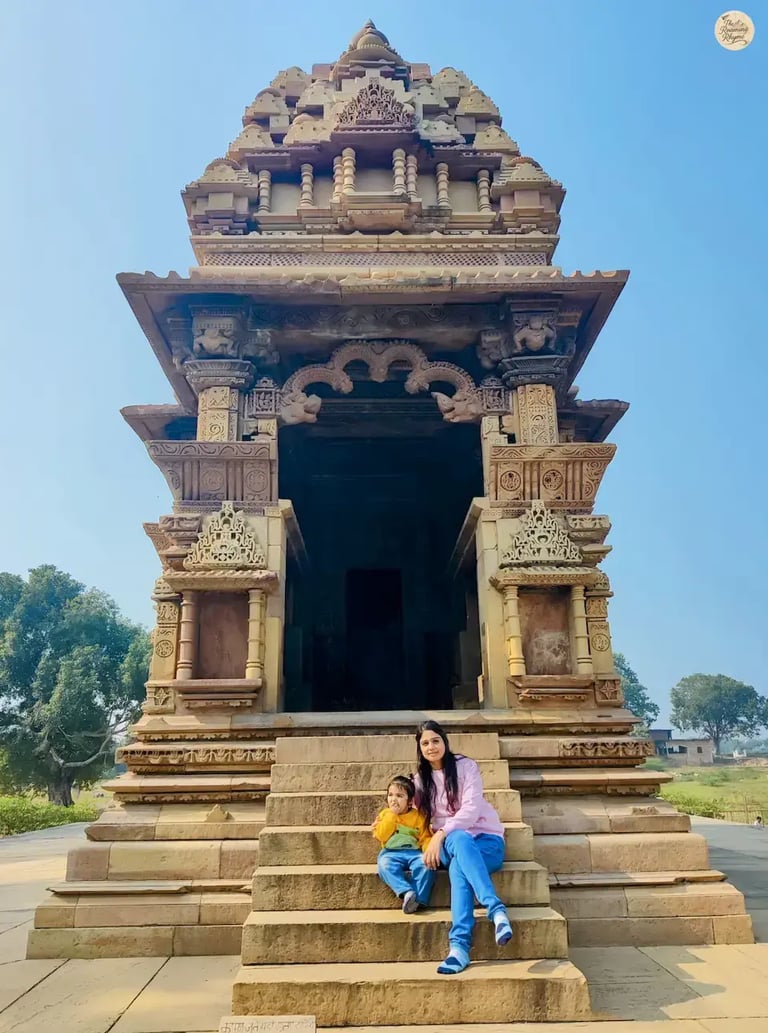Khajuraho Travel Guide – Beyond the Erotic Sculptures
Discover Khajuraho’s ancient temples, art, and legends with this 2-day travel guide — beyond the famous erotic sculptures lies India’s sacred soul.
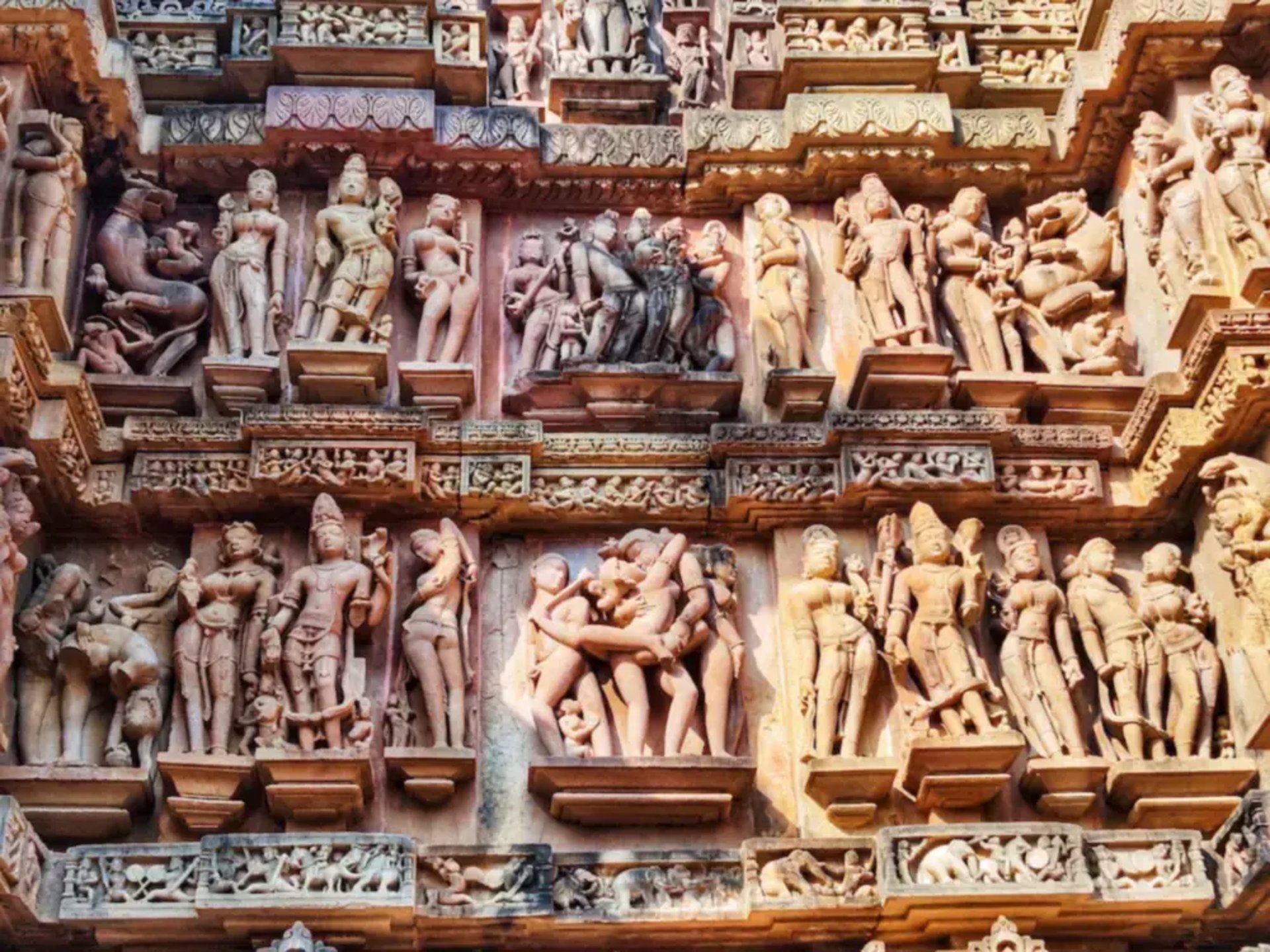
Khajuraho Travel Guide – Beyond the Erotic Sculptures
Explore Khajuraho’s ancient temples and sacred stories in this 2-day travel guide that goes beyond the iconic erotic carvings.
There’s More to Khajuraho Than Just Erotic Art
When people hear the name Khajuraho, the first image that often comes to mind is that of its world-famous erotic sculptures carved into the temple walls. These unique carvings have made the Khajuraho temples world-famous. Some even call them the Kamasutra temples of India, drawing travelers from around the globe. But Khajuraho is much more than its sensual artistry.
Khajuraho had always been on my travel bucket list. To be honest, even I first learned about this place because of the sensual sculptures. But as I read more and explored deeper, my interest in Indian history and architecture showed me a very different side of Khajuraho.
This comprehensive Khajuraho travel guide invites you on a journey beyond curiosity and into the rich heart of India’s spiritual, architectural, and artistic legacy. As a UNESCO World Heritage site, Khajuraho is not just a temple town — it’s a living museum of India’s cultural heritage, tucked away in central India.
Updated on: 04th, Aug 2025
Explored on: Nov' 2024
A Lost World Rediscovered – Khajuraho Temples History
Tucked away in the heart of Madhya Pradesh, Khajuraho is not just a destination—it’s one of India’s most remarkable archaeological wonders. But there’s more to its story than meets the eye.
Long before it became famous for its temples and sculptures, Khajuraho was known as Kharjuravahaka—a name that means “the land of date palms.” Back in the 10th to 12th centuries, this wasn’t just a temple town. It was a thriving spiritual and cultural hub—full of life, art, rituals, and royal patronage.
Each temple here tells the story of a time when art, religion, and architecture flourished under the powerful Chandela dynasty. It’s believed that many of these temples were built in honor of individual Chandela rulers. Even after their rule faded, Khajuraho continued to shine as a sacred site until the 14th century.
But then, as history took new turns, Khajuraho slowly slipped into silence. By the 16th century, it had vanished from the spotlight—untouched by Mughal invasions, yet hidden away from maps and memories.
These temples of Madhya Pradesh were forgotten by history until 1838, when British officer T.S. Burt stumbled upon their splendor hidden deep in forested lands. What he discovered was a stunning example of medieval Indian architecture and symbolism.
Just imagine: walking through wild, overgrown paths and suddenly standing before towering spires and intricate carvings, forgotten by time yet still whispering tales of a glorious past.
Khajuraho Temple Map: West, East & South
In its golden days, Khajuraho was home to nearly 85 majestic temples, beautifully spread across 13 square kilometers—each one a masterpiece in stone. Today, around 26 temples have survived the passage of time, standing proud and poetic like verses from an ancient script.
These temples are now grouped into three distinct clusters: Western, Eastern, and Southern Group of Temples, each with its own rhythm and charm:
Western Group of Temples – These are the grand icons of Khajuraho, home to the Kandariya Mahadev, Lakshmana, and Vishwanath temples. With their towering shikharas and intricate carvings, this group feels like the beating heart of Khajuraho temple architecture.
Eastern Group of Temples – Scattered among quiet lanes and village fields, these temples are a blend of Jain and Hindu artistry. Their simplicity and calm make them perfect for slow, reflective walks.
Southern Group of Temples – Remote, lesser-known, and raw in feel, these temples are hidden gems that speak softly, away from the usual tourist trail.
Best Time to Visit Khajuraho
The ideal time to visit Khajuraho is from October to March, when the weather is pleasant.
If you’re planning a cultural trip, aim for February, when the iconic Khajuraho Dance Festival takes place — a week-long celebration of classical Indian dance set against the dramatic temple backdrop.
How to Reach Khajuraho
Khajuraho is well-connected despite its offbeat location:
By Air: Khajuraho has a domestic airport with flights from New Delhi, Varanasi, and other cities.
By Train: Khajuraho Railway Station connects to major cities like Jhansi, Agra, and even Capital New delhi.
By Road: It’s well-connected via buses and taxis from Agra, Gwalior, and Panna.
If you're traveling to central India, Khajuraho is a worthy detour.
Where to Stay – Hotels in Khajuraho
From luxury resorts to budget homestays, Khajuraho offers plenty of stay options:
Luxury: The Lalit Temple View, Radisson Jass, Hotel Chandela
Mid-Range: Hotel Isabel Palace, Dakghar 606, SYNA Heritage Hotel
Budget: Moustache Khajuraho, local guesthouses near the Western group
Khajuraho Temple Entry Ticket & Timings
Timings:
Western Group of Temples:
Open daily from 8:00 AM to 6:00 PM
Best time to visit: Morning (8–11 AM) or late afternoon (4–6 PM) for beautiful lighting and fewer crowds.Eastern & Southern Groups:
Entry is free, and most temples are accessible during daylight hours (approx. 7:00 AM to 6:00 PM). These are more open and scattered, giving a local village vibe.Light & Sound Show (Western Group Complex):
Hindi: 6:30 PM – 7:25 PM
English: 7:40 PM – 8:35 PM
(Timings may vary by season, so confirm locally.)
Entry Tickets (Western Group of Temples):
Indian Nationals: ₹40 per person
SAARC/ BIMSTEC: ₹40 per person
Foreign Nationals: ₹600 per person
Children <15 years: Free
Tickets are available at the main entry gate near Shivsagar Lake. You can also book through the Archaeological Survey of India.
In Khajuraho's heart, where legends sleep,
Stone tells stories both bold and deep.
Temples rise with timeless grace,
Each carving a poem, each spire a place.
Erotic forms in rhythmic pose,
Life and longing the walls disclose.
Not just desire, but cosmic flow—
Spirit and sensual in Khajuraho.
The sacred meets the sensual here,
A thousand years still drawing near.
Toranas arch like timeless gates,
Where past and present quietly wait.
With every step, a tale to trace,
Through silence, song, and sculpted space.
This ancient town, with soul and chime,
Still hums the tune of The Roaming Rhyme.


To truly connect with the soul of Khajuraho, I’d suggest spending at least two days exploring.
Let Day 1 take you through the iconic Western Group, where grandeur greets you at every turn. Reserve Day 2 for the more serene Eastern and Southern Groups, where silence speaks and time seems to slow down.
If you have an extra day in Madhya Pradesh, consider extending your journey to Orchha — a hidden town of palaces, temples, and timeless charm — or venture into the wild at Panna Tiger Reserve, where nature and silence rule the jungle. Both are just a few hours from Khajuraho and make for perfect cultural or wilderness escapes.
Khajuraho Itinerary – Day 1: Exploring the Western Group of Temples
Start your Khajuraho itinerary with the most famous part — the Western Group of Temples, located near the peaceful Shivasagar Lake. This cluster is the most iconic and well-preserved among all places to visit in Khajuraho. This is also the heart of Khajuraho tourism and where most of the renowned Khajuraho temple carvings can be found.
As you enter, the first temple you’ll see is the beautiful Laxmana Temple. From there, follow the path clockwise, just like most experienced travelers do. This route will take you past other major temples like Kandariya Mahadev, Vishwanath, and finally to Pratapeshwar Temple at the far end.
Lakshmana Temple Khajuraho – The Crown Jewel of a Forgotten Era
Among all the temples of Madhya Pradesh, one that truly commands admiration is the Lakshmana Temple Khajuraho — a stunning blend of devotion, artistry, and spiritual grandeur. Often featured as a highlight in any Khajuraho travel guide, this temple stands as a timeless testament to the cultural heritage of India.
Despite its name, this temple has no connection with Lakshmana, the brother of Lord Rama. Instead, it is dedicated to Vaikuntha Vishnu, a unique multi-faced form of Lord Vishnu. Built in the 10th century under the patronage of the Chandela dynasty, it is one of the earliest and most exquisitely preserved examples of Khajuraho temple architecture, setting the stylistic benchmark for what followed.
As you approach the temple, you’re greeted by intricate and vibrant Khajuraho temple carvings that seem to breathe with life. Every inch of the sandstone façade tells stories — of divine beings, celestial dancers (apsaras), soldiers in motion, musicians, royal hunts, and scenes from daily life like a woman delicately removing a thorn from her foot. These stone panels capture not just art, but ancient Indian life in motion.
And of course, woven into this tapestry are the famous erotic sculptures of Khajuraho — bold yet graceful figures inspired by the Kamasutra. Contrary to popular perception, these sensual depictions represent more than physical union; they are symbolic of harmony between the physical and spiritual, reflecting the philosophy that life, desire, and devotion are not opposites, but parts of the same sacred journey.
Climbing up the steps, you’ll pass under beautifully carved toranas — ornamental gateways that welcome you into a sacred space. Don’t forget to pause and look up. The ceiling carvings inside swirl with geometric designs that reflect cosmic harmony.
Within the inner sanctum lies the rare and awe-inspiring idol of Vaikuntha Vishnu — a composite image featuring three faces: Vishnu in the center, Narasimha (lion-man) on one side, and Varaha (boar) on the other. When the sunlight hits just right, the divine light seems to animate the stone, creating an atmosphere that feels mystical and timeless.
One of the most unique aspects of the Lakshmana Temple Khajuraho is its continuous frieze running along the outer base of the platform. Unlike other temples, this frieze is remarkably preserved, offering vivid scenes of royal hunts, marketplace buzz, dancers mid-performance, and more. It’s this level of storytelling — both sacred and secular — that sets the temple apart.
This was not merely a place of worship; it was envisioned as Mount Meru, the mythological mountain believed to be the axis of the universe in Hindu, Jain, and Buddhist cosmology. In this space, mythology, architecture, and spirituality unite with astonishing grace.
A visit here is more than just sightseeing. It’s an invitation to step into the soul of ancient India, where every carved line has meaning, and every shadow hides a story.
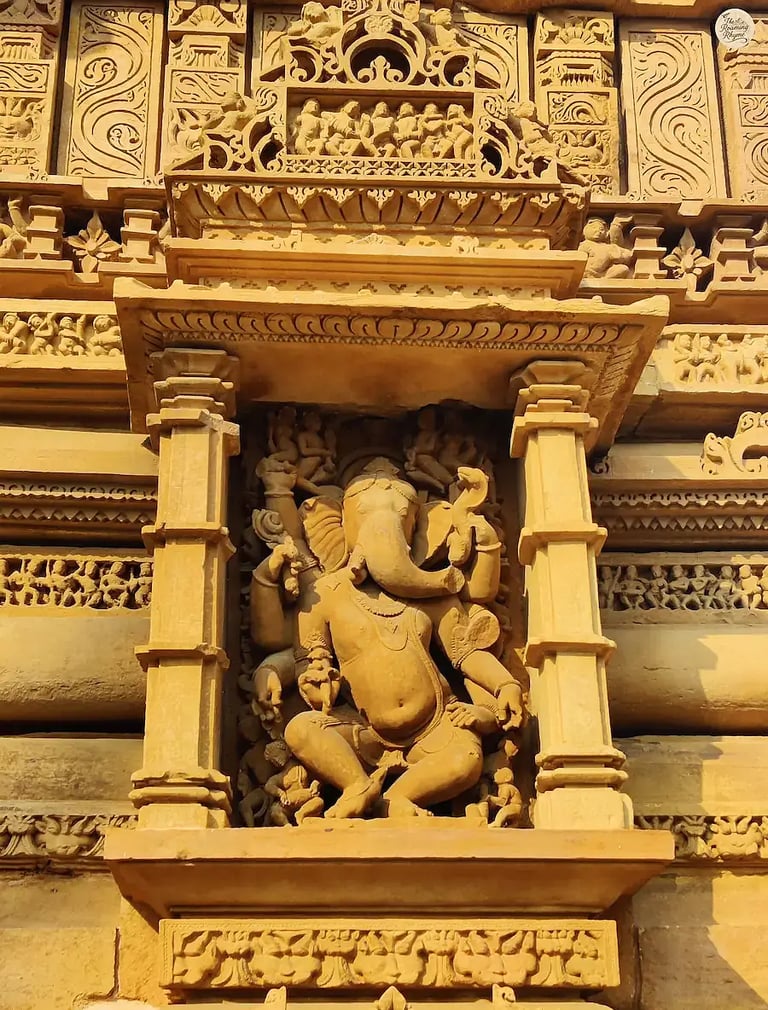

Lord Ganesha at Lakshmana Temple - an auspicious start to Khajuraho’s sacred journey.
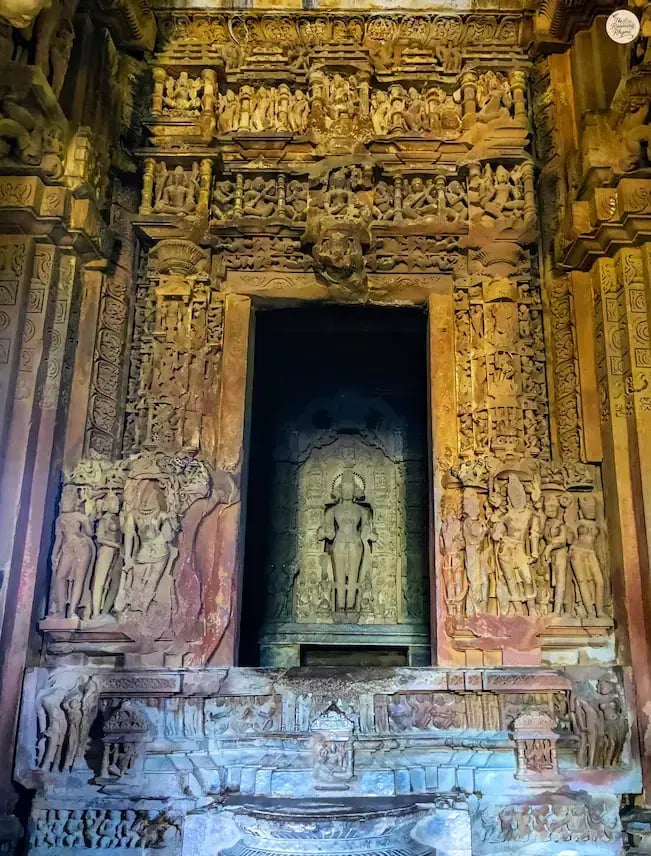

Inside Lakshmana Temple — where every carving whispers a timeless story.
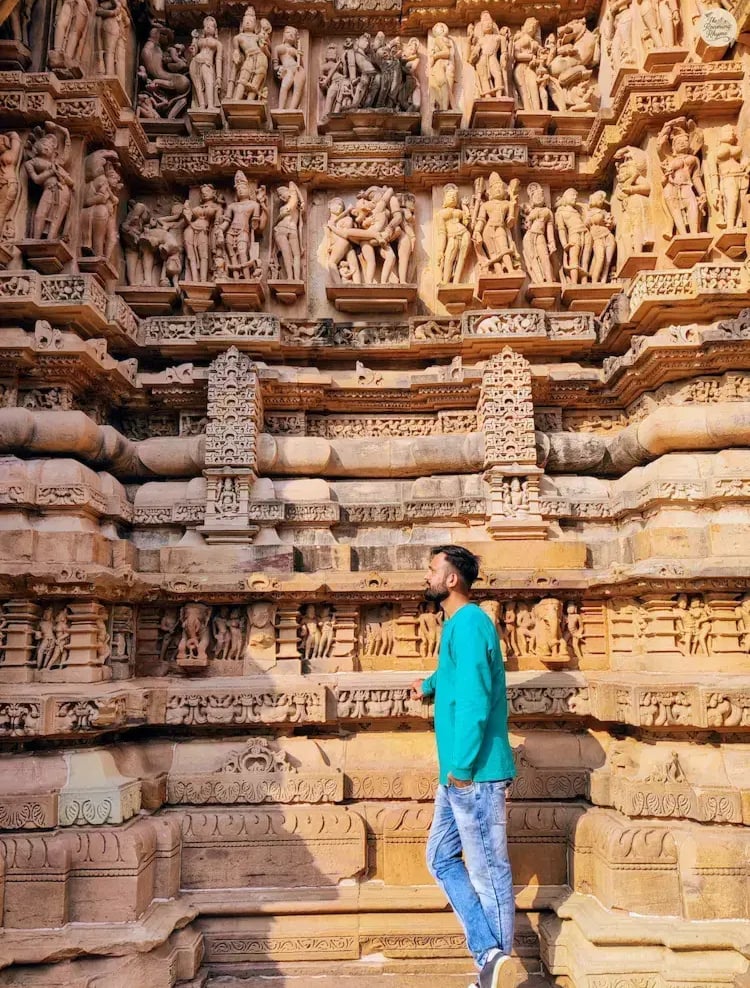

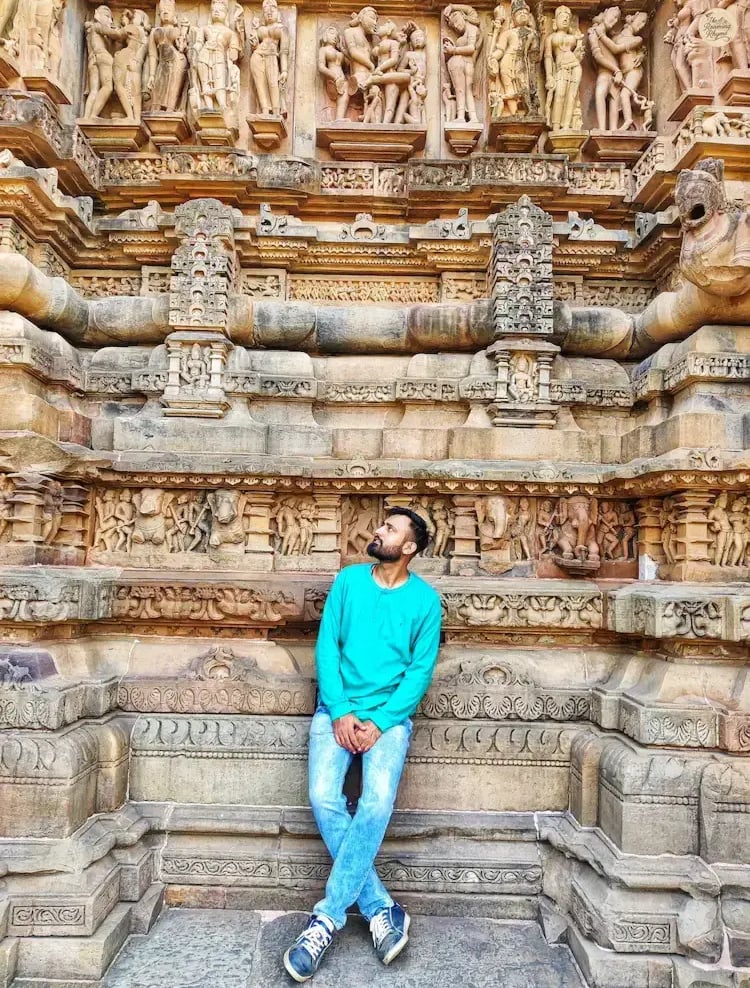

Outer walls of Lakshmana Temple — where divine, sensual, and everyday life unite in stone.
An architectural tapestry — where every inch of stone is a masterpiece.
Varaha Temple Khajuraho – The Silent Guardian of Khajuraho
Just across from the grand Lakshmana Temple, facing the soft morning sun, stands a quieter sentinel — the Varaha Temple Khajuraho. Though smaller and simpler than its neighbors in the Khajuraho group of monuments, it offers something equally profound: stillness, symbolism, and spiritual grace.
Built like an open pavilion, the temple rests on fourteen plain stone pillars with a roof made of layered slabs. A delicately carved lotus flower adorns the ceiling — a sacred symbol of purity often associated with Lord Vishnu.
At its heart is a stunning sculpture — a 2.5-meter-long sandstone statue of Varaha, the third avatar of Vishnu, who lifted the Earth from the cosmic ocean to restore balance. Carved from a single stone, the figure is not only massive but richly detailed: its surface is covered with 675 miniature figures, arranged in twelve rows, depicting gods, sages, and celestial beings. It feels as though the universe itself rests upon the divine boar's back.
Many visitors pass by quickly, drawn to the grander shrines — but this humble structure rewards those who linger. Under its open roof and the eternal gaze of Varaha, you’ll feel the quiet strength that has watched over Khajuraho temple carvings for centuries.
If you're exploring the temples of Madhya Pradesh, don’t miss this silent guardian. In a place where grandeur often steals attention, Varaha Temple proves that true power sometimes lies in the calmest places.
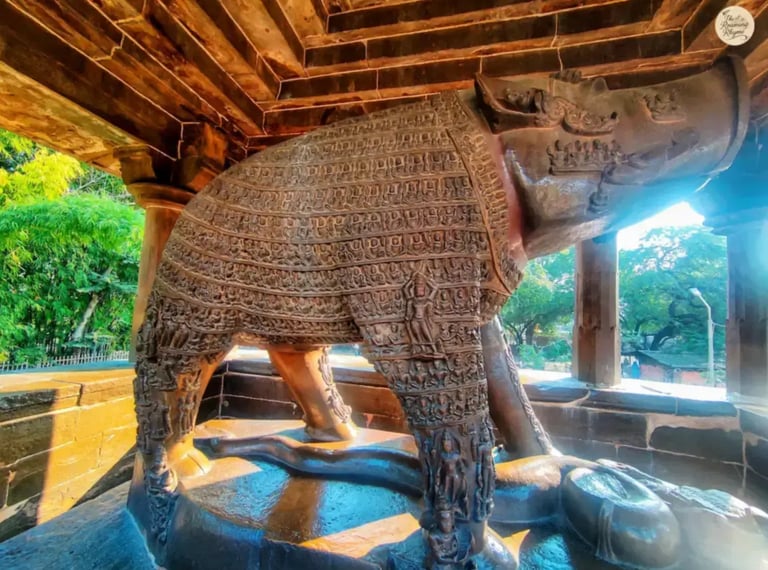

Where mythology meets stone – the divine Varaha at Khajuraho
Kandariya Mahadev Temple Khajuraho – The Tallest Dream of Khajuraho
After pausing in the calm of the Varaha Temple, your path leads to the most majestic sight in all of Khajuraho — the Kandariya Mahadev Temple. This temple isn’t just grand — it feels like a dream carved in stone, rising proudly toward the skies.
Dedicated to Lord Shiva, its name comes from the Sanskrit word Kandara, meaning “cave.” Stepping inside, it truly feels like entering a sacred mountain — quiet, vast, and full of echoes from the past. This is the tallest and largest temple in the Western Group of Temples, and from the moment you see it, it truly takes your breath away.
The main shikhara (spire) rises nearly 31 meters, surrounded by 84 smaller spires that cascade downward like ripples of stone. This architectural harmony reflects not only physical grandeur but deep symbolism rooted in Hindu cosmology — representing Mount Meru, the mythical center of the universe. It’s one of the finest surviving examples of Khajuraho temple architecture.
Our local Khajuraho temple guide shared statistics that are hard to believe until seen in person: over 640 figures carved on the outer walls, and more than 220 sculptures inside. Most are nearly a meter tall, though in pictures they seem much smaller. But when you stand before them, up close, you can truly appreciate the mastery of Khajuraho’s ancient artisans. The level of detail, symmetry, and storytelling carved over a thousand years ago is simply incredible.
Just like the other temples in Khajuraho, these walls tell many stories — scenes from daily life, mythology, musicians and dancers, and yes, the erotic sculptures of Khajuraho. These carvings are full of movement and emotion — bold, artistic, and often acrobatic — but they’re just a small part of the much larger narrative told here in stone.
The steps to the sanctum are once again framed by beautifully carved toranas — stone gateways that welcome you into a sacred space. As you step inside, don’t forget to look up. The ceiling carvings are a world of their own — swirling, intricate patterns that reflect the complex beauty of the universe.
At the heart of the temple, inside the sanctum, stands a highly polished Shiva linga, glowing softly in the natural light. As the sun filters through, it lights up the stone around it, creating a moment that feels both powerful and peaceful — a divine silence wrapped in golden light.
The Kandariya Mahadev Temple Khajuraho is not just a marvel of stonework — it is a spiritual crescendo in this Khajuraho travel guide. A temple that rises like a prayer, echoing the art, devotion, and cosmic dreams of a civilization that once flourished — and still speaks through these eternal walls.
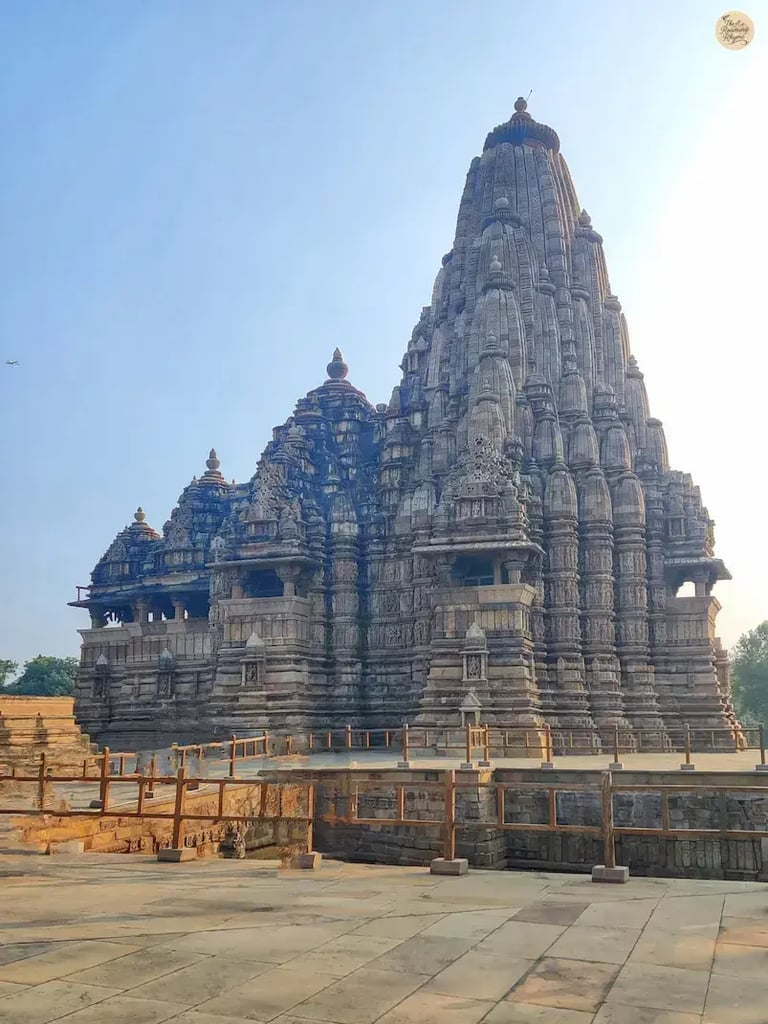

Kandariya Mahadev – The Crown Jewel of Khajuraho’s Sacred Art.
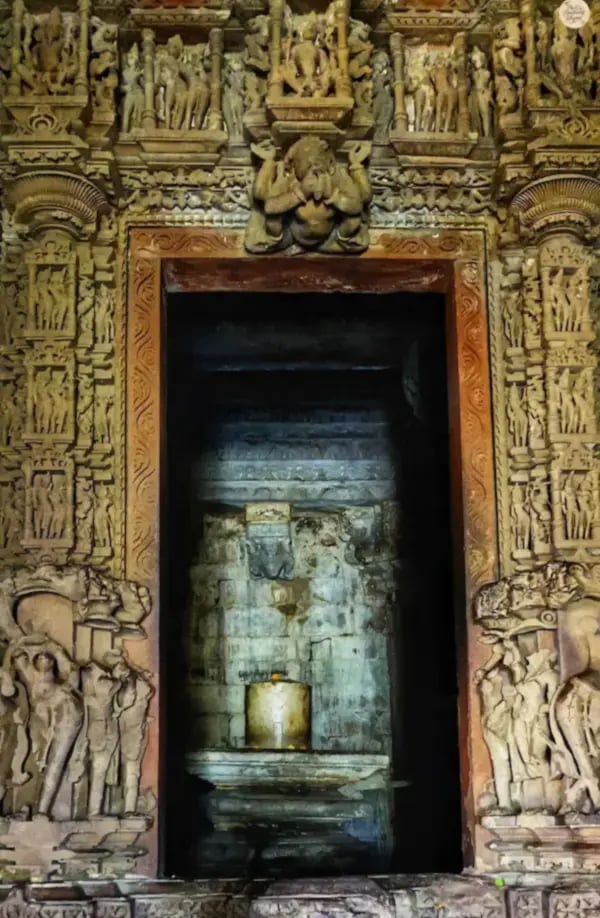

Inner sanctum of Kandariya Mahadev Temple, Khajuraho with detailed stone architecture.
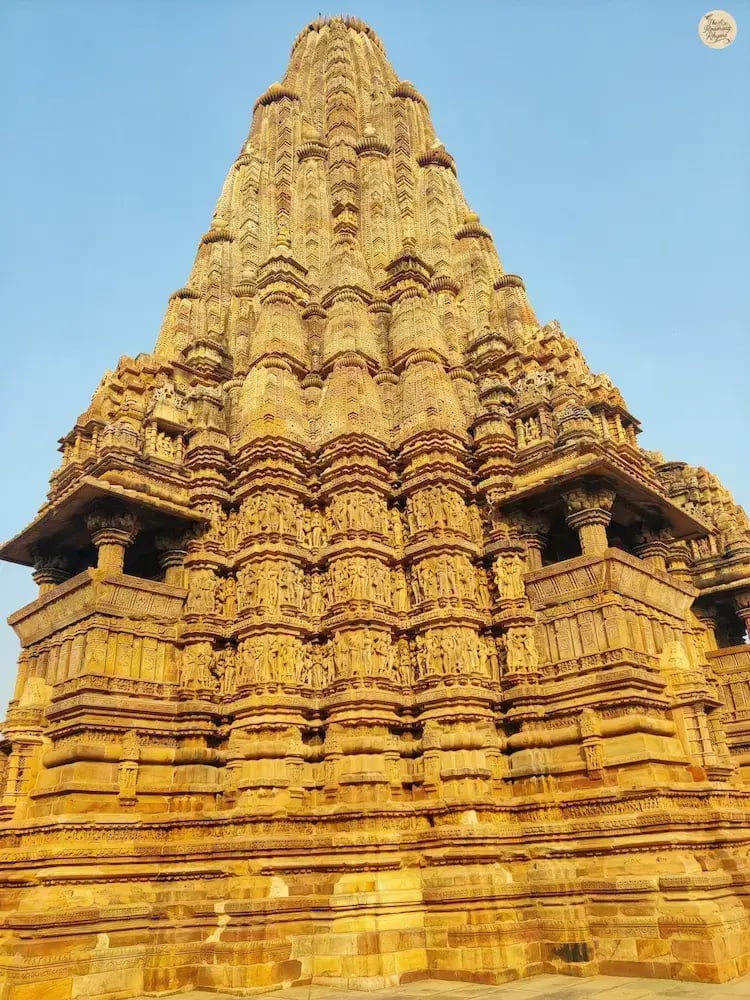

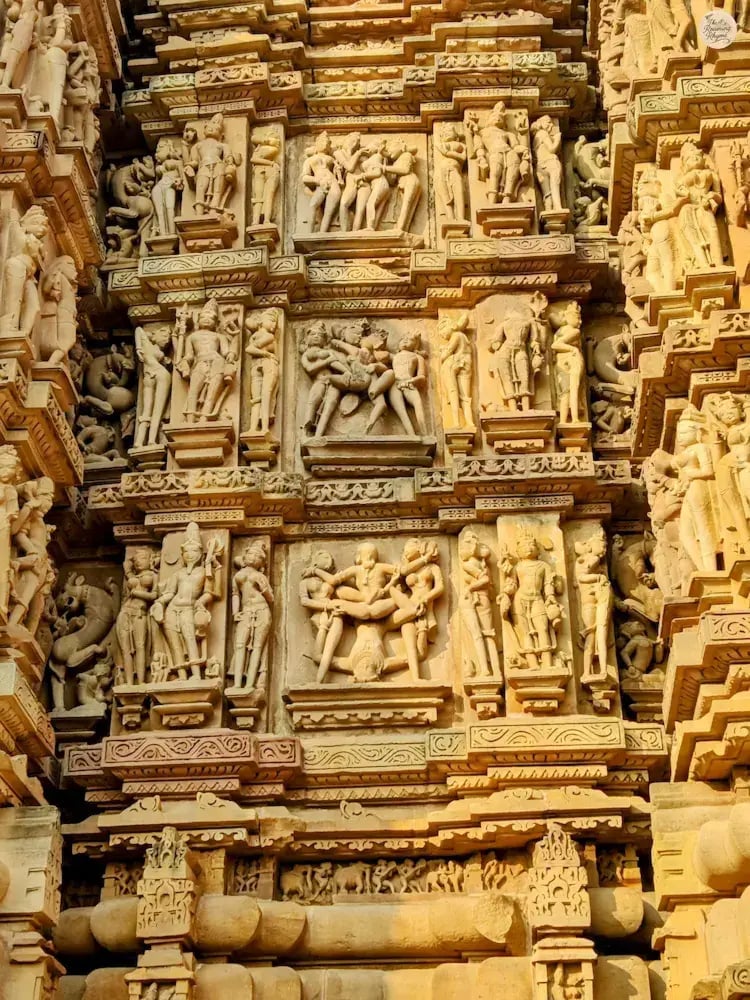

A Symphony in Stone — The Towering Shikhara of Kandariya Mahadev
Where Divine and Desire Meet — Iconic Sculptures on Kandariya Mahadev’s Outer Wall
Mahadeva Shrine Khajuraho – A Quiet Pause Between Giants
As you walk between the towering Kandariya Mahadev Temple and the graceful Jagadambi Temple, a smaller structure quietly shares their platform — the Mahadeva Shrine Khajuraho. Though modest, this shrine offers a moment of stillness between architectural giants in the Western Group of Temples Khajuraho.
Unlike its elaborate neighbors, the Mahadeva Shrine is a simple open canopy, without high spires or grand mandapas. Yet its carvings leave a lasting impression. Guarding its space are powerful Khajuraho temple carvings of mythical creatures — lion-bodied beings with the heads of tigers, elephants, and birds — locked in dramatic battle with humans. These scenes reflect the eternal struggle between man and nature, instinct and spirit, echoing deeper philosophical themes.
Often overlooked by visitors rushing toward larger temples, this small shrine rewards those who pause. Its artistry and symbolism quietly contribute to the cultural richness of the Khajuraho group of monuments.
In a site known for grandeur, the Mahadeva Shrine stands as a reminder that even the simplest structures within the temples of Madhya Pradesh can hold powerful meaning — not through scale, but through soul.
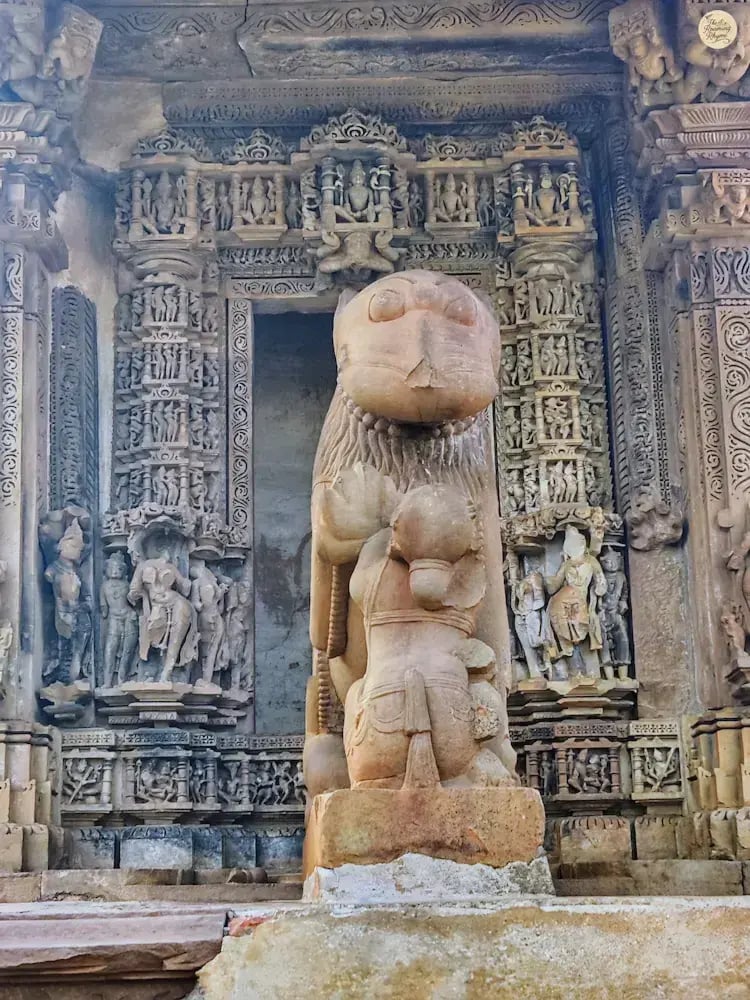

Khajuraho’s Silent Battle — Humans vs Mythical Creature
Jagadambi Temple Khajuraho – Beauty in Silence
On the same raised platform as Kandariya Mahadev Temple and the modest Mahadeva Shrine, stands the serene Jagadambi Temple Khajuraho — also known as the Devi Jagadamba Temple. As part of the Western Group of Temples Khajuraho, this shrine may not be the tallest or most ornate, but its quiet grace makes it an unforgettable stop for anyone following this Khajuraho travel guide.
Unlike the towering temples nearby, Jagadambi’s charm lies in its simplicity. The outer walls are adorned with elegant Khajuraho temple carvings — divine figures, goddesses, celestial dancers — all captured with soft expressions and fluid movements. These carvings may lack the boldness of those found in other monuments, but they resonate with emotional depth and spiritual poise.
By the time you arrive here, especially after touring the more elaborate temples of Khajuraho, you might find yourself craving a gentler space. That’s exactly what Jagadambi Temple offers — a quiet moment to pause, breathe, and reconnect. It’s a spiritual exhale amid the richness of the temples of Madhya Pradesh.
Inside, the sanctum is small and intimate. Subtle carvings on the inner walls whisper age-old stories of devotion. The temple is dedicated to Devi Jagadamba, a powerful form of the Mother Goddess. Her idol may not be large, but her presence is unmistakable — calming, nurturing, and full of silent strength.
In a destination known for grandeur and sensuality, Jagadambi Temple Khajuraho is like a soft devotional hymn — not meant to dazzle, but to stay with you long after you've left. It’s one of those quiet places that reminds you why the cultural heritage of India is as much about reflection as it is about reverence.
A Softer Song in Stone — Jagadambi Temple, Khajuraho
Chitragupta Temple Khajuraho – A Temple Bathed in Sunlight
As you walk toward the northwest edge of the Western Group of Temples Khajuraho, slightly apart from the main concentration of monuments, you’ll find a peaceful yet powerful shrine — the Chitragupta Temple Khajuraho.
At first glance, this temple resembles the nearby Jagadambi Temple, but it carries a radiant uniqueness. It is the only temple in the entire Khajuraho group of monuments dedicated to Surya, the Sun God — making it a rare spiritual space in this cluster of deities and dynasties.
Like other Khajuraho temple carvings, its outer walls are alive with detail. You’ll find finely sculpted panels depicting warriors, celestial dancers, musicians, and vibrant scenes from Hindu mythology and daily life. Despite the sheer number of carvings you may have seen by this point in your journey, the artwork here still feels fresh, expressive, and full of divine light.
Step inside, and the heart of the temple immediately draws your attention — a massive, standing idol of Surya, carved in stone and standing over two meters tall. Wearing armor and boots, with a dignified presence, the deity once held lotus flowers in his hands. Though those are now lost to time, the idol still radiates a warmth that lives up to his celestial identity. You can almost feel sunlight emanating from the sculpture.
Even the shadows here seem subdued — as if humbled by the radiance of the Sun God himself. It’s one of those places where architecture and energy come together seamlessly, offering a moment of stillness that stands apart from the grandeur of the rest of the complex.
For anyone navigating this Khajuraho travel guide in search of less-crowded gems, Chitragupta Temple offers a soulful pause — full of light, symbolism, and quiet power. Tucked away from the tourist trail, it reminds us that even among the grandest of temples, it's often the cultural heritage of India expressed in smaller spaces that leaves a lasting impression.
Vishvanatha Temple Khajuraho – A Quiet Conversation in Stone
Tucked gently along the eastern boundary of the Western Group of Temples Khajuraho, close to the main road yet wrapped in tranquility, stands the Vishvanatha Temple Khajuraho — considered one of the three great masterpieces of this sacred town, alongside Lakshmana Temple and Kandariya Mahadev. For those exploring with the help of this Khajuraho travel guide, this temple is a must-see for its graceful structure and evocative energy.
At first glance, the temple appears majestic, yet approachable. Its warm sandstone walls are adorned in three horizontal layers of sculpture — each one a storybook in stone. You’ll find gods and goddesses, celestial apsaras, musicians, mythological tales, and even the famous erotic sculptures of Khajuraho intricately carved into its surface. Sacred and sensual coexist here in perfect harmony, illustrating the full spectrum of life as envisioned by the artisans of the Chandela dynasty.
Stepping inside, you leave the modern world behind. The ambient noise disappears. The temple’s inner ambulatory path — still intact after centuries — allows you to walk around the sanctum, as worshippers once did. Graceful apsaras are etched onto the pillars, their postures so fluid they seem to sway in the filtered light.
Sunlight pours in through narrow balconies, casting golden patches across the temple’s interior. There’s no rush here. Just a quiet presence. A stillness that allows the temple to whisper — not shout — its stories.
Before leaving, be sure to turn around. Opposite the sanctum, you’ll find something rare: the original Nandi Mandapa. This sacred pavilion, resting on twelve robust pillars, houses a stately figure of Nandi, the bull and devoted companion of Lord Shiva. He gazes eternally toward the sanctum — a silent guardian standing watch for over a thousand years.
Though not the tallest among the temples of Madhya Pradesh, the Vishvanatha Temple Khajuraho leaves an impression that runs deep. It’s a space where architecture, symbolism, and serenity come together — a site that truly reflects the timeless elegance of the cultural heritage of India.
Sacred Grandeur Standing Still — Vishvanatha Temple, Khajuraho
The Bold Legacy of Khajuraho — Vishvanatha’s Outer Sculptures
Pratapeshwar Temple Khajuraho – A Gentle Goodbye in Stone
As you complete the clockwise trail through the Western Group of Temples Khajuraho, your final stop brings you to a quieter, more modern presence — the Pratapeshwar Temple Khajuraho. For anyone walking this path with the guidance of a thoughtful Khajuraho travel guide, this last temple offers a soft landing after a journey through centuries of sacred stone.
Immediately, you’ll notice a shift in style and atmosphere. This temple feels different — and it is. Constructed in the 20th century, nearly 800 years after the last of the Chandela dynasty's temples, Pratapeshwar stands as a more recent tribute to India’s enduring spiritual architecture.
Its design blends multiple influences: a Rajput-style dome at the entrance, a pagoda-inspired ceiling in the central chamber, and a tall Brahminical shikhara at the rear, reminiscent of the chhatris of Orchha. Though contemporary in origin, the temple thoughtfully echoes the regional architectural language of the temples of Madhya Pradesh.
Inside, the mood is calm and unadorned. The sanctum holds a simple black polished Shiva Linga, set against plain stone walls. Unlike the elaborate Khajuraho temple carvings that define the older temples, Pratapeshwar embraces simplicity — its silence speaking volumes.
There’s something deeply peaceful about this space. It feels like a closing note, a final breath at the end of a grand symphony. Though it may not carry the weight of ancient legend, the Pratapeshwar Temple still belongs to the same sacred soil. It honors the past while quietly holding space in the present.
For the reflective traveler, this temple is more than an afterthought. It is the final chapter of a story deeply rooted in the cultural heritage of India. A place to pause, reflect, and say goodbye to Khajuraho’s temple trail — with a heart full of stillness and wonder.
Matangeshvara Temple Khajuraho – Where Devotion Still Breathes
As you step outside the main complex of the Western Group of Temples Khajuraho, and follow the quiet trail near the exit gate, you’ll encounter a different kind of sacred space — one that’s not just admired, but actively lived in. This is the Matangeshvara Temple Khajuraho, the only living temple in Khajuraho where daily rituals and prayers are still offered.
While most temples in this Khajuraho travel guide are celebrated for their architecture, sculpture, and history, Matangeshvara is something more — a bridge between past and present. It may lack the towering shikharas of Kandariya Mahadev or the detailed carvings of Lakshmana Temple, but it holds something far more powerful: uninterrupted, living devotion.
At the heart of the shrine stands a colossal Shiva Linga, nearly 18 feet tall, making it the second-largest in India after the Bhojeshwar Temple in Bhojpur. Local belief says that only half of it is visible above ground — the rest lies hidden, rooted deep in the earth, like the spiritual traditions that continue to thrive here.
The moment you enter, the temple comes alive through your senses — the fragrance of incense, the ringing of bells, the sound of Sanskrit chants, and the sight of locals offering flowers and water, as they have for generations. It is a space where stone meets soul, and where the cultural heritage of India isn't frozen in time — it's breathing, moving, praying.
Unlike the quiet reverence of the archaeological monuments nearby, the Matangeshvara Temple pulses with daily life. It stands as a powerful reminder that these sacred spaces were never meant to be museums — they were, and in this case still are, living vessels of faith.
As your journey through the temples of Madhya Pradesh nears its end, this humble shrine offers a heartfelt farewell — not with grandeur, but with grace. Stand here for a moment, and you’ll feel it too — the soft, steady heartbeat of Khajuraho’s living spirit, still echoing through this sacred stone.
Still Worshipped, Still Sacred — Matangeshwar Mahadev
Evening in Khajuraho – Souvenirs, Stillness & Stories in Light
After offering prayers at the Matangeshvara Temple, the only living shrine in this sacred town, your Day 1 journey through the Western Group of Temples Khajuraho gently winds down. But before calling it a day, there’s still a touch of magic waiting in the quiet evening air — an essential part of this Khajuraho travel guide.
Take a leisurely stroll through the charming local markets of Khajuraho, located just outside the temple complex. Here, you’ll find beautiful souvenirs — intricately carved stone sculptures, fridge magnets, miniature temple replicas, and the region’s prized bamboo silk sarees. Lightweight and earthy, these sarees are unique to this part of Madhya Pradesh and make for a meaningful keepsake or gift.
As twilight deepens, consider attending the Khajuraho Light and Sound Show, held every evening in the temple complex. With dramatic lighting and soulful narration, the show tells the story of the Chandela dynasty and the divine philosophy behind Khajuraho’s temple art. Watching the sculptures light up under the stars brings a new dimension to what you explored by day, making this one of the most memorable things to do in Khajuraho at night.
By now, the crowds have thinned, the stone pathways quiet. You return to your stay carrying a sense of stillness — and maybe a few stories of your own. Rest well, because Day 2 of your Khajuraho itinerary awaits — a day dedicated to the Eastern and Southern Group of Temples, where the quieter corners of Khajuraho reveal their own hidden brilliance.
Khajuraho Itinerary – Day 2: Eastern & Southern Temples
As a new day unfolds, your Khajuraho itinerary shifts its pace gently. Today’s path leads you toward the Eastern and Southern Group of Temples in Khajuraho — quieter, more scattered, and deeply woven into the daily rhythm of village life. If Day 1 was about grandeur and drama, Day 2 is about stillness, simplicity, and soulful discovery.
Unlike the towering shrines of the Western Group of Temples, these monuments are not grouped on elevated platforms or behind ticket gates. Instead, they appear along village paths, open fields, and dusty roads — blending humbly into the rural landscape of Madhya Pradesh.
There’s no rush here. These temples invite you to slow your steps, to listen more than look, and to let the spiritual heritage of Khajuraho unfold quietly. Whether it’s the finely carved Jain temples in Khajuraho or the southern shrines that stand in quiet reverence, this part of your Khajuraho travel guide offers a chance to connect with the sacred in a more personal way.
In these lesser-known corners, away from the tourist trail, you’ll find a gentler voice of the past — one that whispers rather than declares. A walk through these temples is a walk through time itself — a subtle, beautiful continuation of the story Khajuraho has been telling for over a thousand years.
Brahma Temple Khajuraho – A Peaceful Start to the Eastern Group of Temples
Your journey through the Eastern Group of Temples Khajuraho, begins gently — with the Brahma Temple, resting peacefully beside the still waters of Khajur Sagar Tank, framed by village rooftops and distant fields. There’s a certain calm here, as if time itself slows down.
Despite its name, the Brahma Temple isn’t actually dedicated to Lord Brahma. Step inside, and you’ll find a rare four-faced Shiva Linga, which once led people to believe it was Brahma — and so the name stayed. Like much of Khajuraho’s mythology, this too is a story wrapped in layers of history and faith.
The temple itself is modest, far removed from the grandeur of the Western Group. There are no elaborate Khajuraho temple carvings, no towering shikharas or large mandapas. But within its simplicity lies a quiet elegance. The stone lattice windows let in filtered light, while the carved figures of Ganga and Yamuna stand poised at the entrance — eternal sentinels of sacred waters and sacred spaces.
Above, a small pyramidal shikhara rises softly into the sky, hinting at an era where devotion was more intimate than ornate. There are no crowds here — just the sound of the breeze, the glint of sunlight on stone, and the quiet grace of a shrine that has stood for centuries in stillness.
The Brahma Temple may not dazzle, but it grounds you. It reminds you that the temples of Madhya Pradesh are not just about spectacle — they are about silence, simplicity, and connection. And for those following this Khajuraho travel guide, it is the perfect starting note to a softer, more personal melody that Day 2 has in store.
Vamana Temple Khajuraho – Where the Dwarf Avatar Stands Tall in Art
A short walk northeast from the Brahma Temple, around 200 meters along a quiet path, brings you to the charming Vamana Temple Khajuraho — another gem in the Eastern Group of Temples Khajuraho, and a graceful chapter in this Khajuraho travel guide.
Dedicated to Vamana, the fifth avatar of Lord Vishnu, this temple tells the tale of the gentle dwarf Brahmin who used wisdom — not power — to humble the mighty King Bali. In a region known for towering spires and grand structures, it’s touching to see a shrine that celebrates humility and intelligence above force.
Though smaller than the monumental temples of the Western Group, Vamana Temple delights with intricate Khajuraho temple carvings that feel refreshingly personal. Instead of larger-than-life deities or mythological beasts, the sandstone walls are filled with soft glimpses of daily life — a woman adjusting her anklet, another fixing her hair, one more removing a thorn from her foot. These subtle moments bring a sense of warmth and humanity that is rare and beautiful.
Step into the sanctum, and you’ll find a round-faced idol of Vamana, carved with gentle simplicity — calm, curious, and kind. There is no grandeur here, only grace. It’s a quiet reminder that even the smallest figures in mythology can carry the deepest spiritual truths.
Surrounded by silence, sky, and open space, the Vamana Temple Khajuraho offers a peaceful pause — a space where faith, folklore, and fine craftsmanship come together. For anyone following this Khajuraho travel guide, it’s a stop that reflects the softer soul of the temples of Madhya Pradesh.
Grace in Simplicity — The Vamana Temple of Khajuraho
A Divine Dwarf in Stone — Sanctum of Vamana Temple
Human Moments in Divine Stone — The Artistic Charm of Vamana Temple
From Anklets to Eternity — Subtle Life Scenes on Vamana Temple Walls
Javari Temple Khajuraho – A Quiet Shrine Among Fields and Legends
Javari Temple — A Quiet Gem Among Khajuraho’s Eastern Treasures
Javari Temple — A Serene Facade Amid Khajuraho’s Hidden Heritage
Just 200 meters south of Vamana Temple, nestled amid open fields and quiet lanes, you’ll find the Javari Temple Khajuraho — a peaceful countryside sanctuary that feels far removed from the grandeur of the main complexes. As part of the Eastern Group of Temples Khajuraho, this little shrine offers a soul-soothing pause in your Khajuraho travel guide.
The name “Javari” is believed to have come from javara, the local word for millet — a grain still cultivated in these surrounding lands. Like the crop it’s named after, this temple may seem modest at first, but it holds deep roots in the cultural and spiritual heritage of the region.
Though smaller than the grand monuments of the Western Group, Javari Temple is a textbook example of elegant temple architecture. It features a sanctum (garbhagriha), vestibule, mandapa, and a graceful front porch — all in harmony. The highlight here is the makara-torana, an intricately carved stone arch above the entrance, adorned with mythical creatures, floral vines, and flowing patterns that seem to welcome you into a story told in stone.
Inside, the sanctum once housed a statue of Lord Vishnu, which now stands headless with the passage of time. Yet the atmosphere within remains sacred and serene, and the artistry on the temple’s walls continues to echo the legends and devotion of the past.
The Javari Temple Khajuraho may not attract crowds or feature in most travel brochures, but it’s one of the most peaceful and lesser-known temples in Khajuraho. Here, local life, mythology, and timeless architecture blend softly under wide-open skies — making it a truly rewarding stop in your temples of Madhya Pradesh journey.
Adinatha Temple Khajuraho – A Peaceful Blend of Jain and Hindu Heritage
As your path weaves deeper into the Eastern Group of Temples Khajuraho, you’ll arrive at a peaceful corner where faith, history, and art come together in quiet harmony. Here stands the Adinatha Temple Khajuraho — one of the most beautiful and spiritually significant Jain temples in Khajuraho, dating back to the late 11th century.
From the outside, the temple follows a classic layout: a sanctum (garbhagriha), a small vestibule, and a porch — the latter added in more recent centuries. But it’s the stonework that truly captivates. The exterior is wrapped in three delicate bands of carvings, filled with celestial apsaras — their flowing postures and intricate ornaments frozen in a timeless dance.
Look closely at the carvings, and you’ll notice something extraordinary: images of Hindu deities subtly included on this Jain shrine. This blending of iconography reflects a period of remarkable religious harmony in Khajuraho, where Jain and Hindu communities lived side by side and often shared artistic traditions.
Inside the sanctum sits a serene black stone idol of Tirthankara Adinatha, the first spiritual teacher in Jainism. Even today, the temple remains active. You might hear soft prayers being whispered or see a local devotee offering flowers — a gentle reminder that this is still a living space of devotion.
Behind the temple, a narrow staircase leads downward — possibly toward an ancient water source. It adds a layer of quiet mystery to the sacred stillness of the space.
For anyone exploring with the help of this Khajuraho travel guide, the Adinatha Temple offers more than just stunning architecture — it offers a meaningful pause, where temples of Madhya Pradesh reflect not just stone craftsmanship but shared faith and unity.
Parshvanatha Temple Khajuraho – Silent Walls, Graceful Stories
In the heart of the Jain temple complex within the Eastern Group of Temples Khajuraho, stands the serene and intricately detailed Parshvanatha Temple Khajuraho. Though it’s not the largest temple in the complex, it is often considered one of the most artistically refined — quietly resonating with beauty, history, and spiritual depth.
Originally dedicated to Tirthankara Adinatha, the temple today houses an idol of Parshvanatha, the 23rd of the Jain Tirthankaras. Architecturally, it’s simple — with no side balconies or projecting arms — giving the structure a calm, compact presence that feels almost meditative.
But step closer, and the outer walls come alive. They’re adorned with some of the most delicate Khajuraho temple carvings — women writing letters, adjusting their ornaments, or captured mid-dance with gentle grace. These subtle scenes showcase a more introspective side of Khajuraho’s temple art. Unlike the famous erotic imagery found in many of the Western Group of Temples, the Parshvanatha Temple remains free of such depictions — standing apart with its quiet elegance.
Inside, the layout follows the traditional Jain temple design — a sanctum with a path for circumambulation, a small vestibule, and a mandapa with an ornately decorated ceiling. The idol of Parshvanatha sits beneath a beautifully carved serpent-hood halo, radiating stillness and spiritual clarity.
Before you exit, take a slow walk around the back of the temple. In a modest shrine, you’ll find a peaceful image of Adinatha, subtly reinforcing the temple’s original dedication and the enduring continuity of Jain faith in this sacred space.
For those exploring with this Khajuraho travel guide, the Parshvanatha Temple Khajuraho offers more than just remarkable stonework. It offers a moment of grace — a place where silence, devotion, and the temples of Madhya Pradesh come together in timeless harmony.
Shantinatha Temple Khajuraho – Where the Past Still Breathes
As you continue your walk through the Eastern Group of Temples Khajuraho, you’ll eventually reach the Shantinatha Temple Khajuraho — the spiritual center of the Jain temples in Khajuraho, and a place where devotion, history, and living tradition come together in quiet harmony.
More than just a single shrine, Shantinatha is a working Jain temple complex, where ancient fragments of the past rest beside reconstructed structures from later centuries. Here, you’ll find modern marble blending with weathered sandstone, and daily rituals merging with echoes of ancient chants — a rare and powerful reminder that Khajuraho is not just a gallery of ruins, but a place where faith still lives.
At the heart of the courtyard, the main sanctum houses a magnificent 4.3-meter idol of Adinatha, the first Jain Tirthankara. Polished to a radiant glow, the idol exudes an aura of peace. The moment you step inside, the serene expression on Adinatha’s face seems to reach out across time — a silent gaze that draws you into stillness.
To the right of the entrance, don’t miss the Yaksha-Yakshini couple — one of the few surviving fragments from the original structure. Their presence grounds the temple in its deep historical roots, standing firm amid the more recent additions.
Unlike many other temples of Madhya Pradesh, this one remains a living temple — a sacred space where worship continues, offerings are made, and prayers still echo softly beneath the temple dome.
For readers following this Khajuraho travel guide, the Shantinatha Temple offers more than architecture — it offers a living experience of Jain faith, of spiritual continuity, and of the quiet resilience that has allowed this heritage to endure, gently and beautifully, through the centuries.
Duladeo Temple Khajuraho – Whispers from a Fading Golden Age
About 700 meters southwest of the Jain temples in Khajuraho, hidden in the quieter outskirts of the Southern Group of Temples Khajuraho, stands the Duladeo Temple — a silent sentinel marking the twilight of a glorious era. Often believed to be the last grand temple constructed under the Chandela dynasty, this shrine feels like the final verse in a poem sung in sandstone.
Dedicated to Lord Shiva, the Duladeo Temple Khajuraho follows a modest yet dignified layout — featuring a sanctum, vestibule, mandapa, and porch, though it notably lacks the inner ambulatory path found in earlier temples. It’s a structure that reflects a shift — from the bold architectural confidence of the Western Group of Temples to a gentler, more introspective design, as if the temples of Madhya Pradesh themselves were preparing for silence.
The exterior carvings here reveal the subtle change. Where earlier temples boasted fluid, dynamic sculptures, Duladeo’s figures appear sharper, more rigid — beautiful in their own way, yet clearly shaped by a different artistic hand. Some historians believe this shift signifies not just aesthetic evolution but also a spiritual introspection at the close of an age.
Inside the sanctum lies a Shiva linga, believed to have been installed later, surrounded by 999 miniature lingas — as if a thousand prayers were carved into stone to keep the sacred flame alive just a little longer.
Though it may not enjoy the fame of Kandariya Mahadev or Lakshmana Temple, the Duladeo Temple holds a quiet power. It’s a place where Chandela dynasty architecture offers its final bow — and where the enduring devotion to Lord Shiva reminds you that even as empires fade, faith continues to stand tall.
Chaturbhuj Temple Khajuraho – A Golden Glimpse of Divinity
Tucked quietly to the south of the main temple clusters, about 650 meters from Jatkari village and not far from the airport, stands the Chaturbhuj Temple Khajuraho — also known locally as the Jatkari Temple. Modest in size and simple in design, this serene shrine belongs to the Southern Group of Temples Khajuraho and offers one of the most spiritually uplifting experiences in the region.
The temple follows the classic layout seen across many temples of Madhya Pradesh — with a sanctum, vestibule, mandapa, and porch. But here, ornamentation gives way to serenity. Unlike other temples in Khajuraho, there are no erotic sculptures or intricate wall panels. Instead, the focus rests entirely on the divine energy radiating from within.
Step into the sanctum and behold the highlight of this sacred space — a majestic 2.75-meter-high idol of Lord Vishnu, carved from a single piece of stone, standing with four arms in tranquil grace. It is not only the tallest idol in Khajuraho, but also one of the most awe-inspiring representations of Vishnu temples in northern India.
Visit around sunset, and you’ll witness something extraordinary — as the golden rays of the setting sun slip through the doorway, the idol glows with a radiant light. In that silent moment, stone becomes spirit, and the temple transforms into a timeless sanctuary where nature and divinity bow to each other in harmony.
For travelers following this Khajuraho travel guide, Chaturbhuj Temple is more than a destination — it’s a revelation. A sacred pause where light meets faith, where simplicity becomes sublime, and where the eternal presence of Vishnu continues to shine — quietly, gracefully, and forever.
The Erotic Sculptures – More Than Just Curiosity
At some point, every Khajuraho tour brings up its most talked-about feature — the erotic sculptures. They’re famous, often misunderstood, and sometimes even joked about. But if you listen to a good guide, you’ll hear deeper meanings in the stone.
These carvings, found mostly on the outer walls, are believed to represent:
Tantric practices, where physical union symbolizes spiritual energy.
Inspiration for warriors before battle — a reminder of life and love.
Educational guidance — open-air teachings in the spirit of the Kamasutra.
And above all, they reflect that life in Khajuraho was seen as a balance of the physical, spiritual, and artistic.
It’s also important to note — only about 10% of Khajuraho’s carvings are erotic in nature. The remaining 90% show everything from gods and musicians to dancers, animals, and everyday village life.
But yes, it’s that 10% that everyone remembers — and perhaps that’s what makes them even more fascinating.
Things to Do in Khajuraho – Beyond the Carved Walls
While the temples of Khajuraho are the soul of the town, there’s much more to discover beyond their stone silhouettes. Here are some beautiful ways to deepen your experience:
Attend the Light and Sound Show
Held every evening near the Western Group, this immersive Light and Sound Show tells the story of Khajuraho’s temples and the Chandela dynasty, using narration, music, and shifting lights to animate the ancient stones.Visit Local Craft Markets
Wander through Khajuraho’s colorful bazaars, where you’ll find bamboo silk sarees, miniature stone sculptures, and handmade tribal crafts — perfect souvenirs that carry the local spirit home with you.Watch the Khajuraho Dance Festival (if visiting in February)
Experience India’s classical dance forms under the stars at this celebrated annual event called Khajuraho Dance Festival, where temple backdrops and timeless rhythms blend into one unforgettable cultural night.Visit the Tribal and Folk Art Museum
Located near the Western Group of Temples, the Tribal and Folk Art Museum in Khajuraho offers a rich look into the traditional lifestyles, beliefs, and art of the tribal communities of Madhya Pradesh. A quiet gem that deepens your understanding of the region’s roots.Take a Bicycle or Walking Tour
Let the Khajuraho group of monuments unfold slowly, either by foot or on a guided bike ride. You’ll explore not only the temples but also village life, forest trails, and lesser-known stories that bring Khajuraho to life.
Khajuraho Travel Tips
Exploring the temples of Khajuraho is a journey through time, art, and devotion — and a few mindful preparations can make your experience even more meaningful:
Dress Modestly: These are sacred sites, still revered by locals. Light, respectful clothing will help you stay comfortable and culturally mindful.
Footwear Tips: Wear sandals or shoes that are easy to remove — you’ll need to take them off before entering every temple.
Fuel Up First: Before you enter the complex, it’s a good idea to have a heavy breakfast or early lunch. The Khajuraho temple complex is vast, and you’ll be exploring it entirely on foot. It usually takes 4 to 5 hours to truly absorb everything — especially if you opt for a guided tour (which I highly recommend for first-time visitors).
Hire a Local Guide: A certified Khajuraho temple guide can make all the difference. Their stories breathe life into the sculptures — helping you understand the spiritual, historical, and symbolic depth hidden in every carving.
Souvenir Shopping: Don’t leave without exploring the small markets. Look for miniature stone sculptures and the region’s unique bamboo silk sarees — soft, earthy, and distinctly Madhya Pradesh.
Photography: It’s allowed across most of the complex, but always be respectful. Avoid flash near active shrines, and ask for permission before photographing people.
With a little planning and open-hearted curiosity, Khajuraho becomes more than just a destination — it becomes a personal connection to something timeless.
Khajuraho is not just a tourist destination — it is a poem in stone, a timeless window into the cultural heritage of India. If you’re traveling to central India, make sure Khajuraho is on your list. Its temples don’t just stand — they speak. They don’t just tell stories — they invite you into them.
Whether you’re a history lover, an architecture enthusiast, or just a curious traveler, this Khajuraho travel guide helps you explore the many layers of a forgotten world rediscovered.
Frequently Asked Questions – Khajuraho Travel Guide
Q. What is Khajuraho famous for?
A. Khajuraho is known for its ancient temples with intricate carvings, blending spirituality, mythology, and a few erotic motifs — all carved with exceptional artistry.
Q. Is Khajuraho only about erotic art?
A. Not at all. While the erotic sculptures draw attention, most carvings depict deities, daily life, music, dance, and divine stories — offering a much deeper cultural and spiritual experience.
Q. How many days are enough to explore Khajuraho?
A. Two days are ideal — one for the Western Group of Temples and one for the Eastern and Southern Groups.
Q. When is the best time to visit Khajuraho?
A. October to March is best for pleasant weather. Visit in February for the Khajuraho Dance Festival.
Q. Is photography allowed in the temples?
A. Yes, photography is allowed, but tripods may be restricted. Always be respectful, especially inside active shrines.
Q. Are local guides available at Khajuraho?
A. Yes, certified guides are available at the entrance and can enhance your visit with historical and mythological insights.
Q. Is there a dress code for Khajuraho temples?
A. Dress modestly, covering shoulders and knees. Shoes must be removed before entering the temple interiors.
Q. Can we visit Khajuraho with the family?
A. The Western Group of Temples is open from 6:00 AM to 6:00 PM. Entry is ₹40 for Indians and ₹600 for foreign nationals (free for children under 15).
Q. What to buy from Khajuraho?
A. Look for bamboo silk sarees, miniature stone carvings, local jewellery, and folk art at craft markets.
Q. What other places can I visit near Khajuraho?
A. Orchha is a beautiful next stop — known for its riverside palaces and the majestic Orchha Fort. You can also explore Panna Tiger Reserve, a wildlife sanctuary just an hour away, ideal for spotting tigers, leopards, and crocodiles in the wild.
Share Your Thoughts – We’d Love to Hear From You!
Every journey is better when shared.
We hope you enjoyed this travel story — now, we'd love to hear yours! Share your experience, suggestions, or feedback and help us make our travel tales even better.

